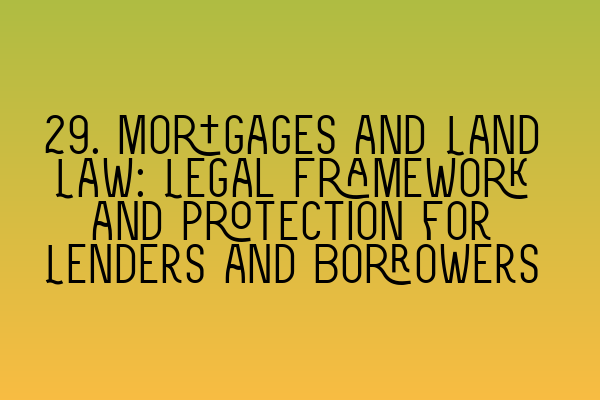29. Mortgages and Land Law: Legal Framework and Protection for Lenders and Borrowers
When it comes to property transactions, mortgages play a crucial role in providing financial assistance to both buyers and sellers. Understanding the legal framework and the protection offered to lenders and borrowers is essential for anyone involved in property law. In this blog post, we will explore the key concepts surrounding mortgages and land law, shedding light on the rights and responsibilities of each party involved.
The Legal Framework
In the United Kingdom, the legal framework governing mortgages and land law is based on common law and statutory legislation. The Law of Property Act 1925 and the Land Registration Act 2002 are the primary legislations that outline the legal requirements and procedures involved in mortgage transactions. These laws ensure the enforceability and protection of rights for lenders and borrowers.
The Law of Property Act 1925 sets out the basic principles of mortgage law, covering areas such as the creation, transfer, and discharge of mortgages. It defines a mortgage as a legal agreement where a lender provides funds to a borrower in exchange for the borrower’s property as security for the loan. This agreement is typically documented in a mortgage deed, which outlines the terms and conditions of the loan.
The Land Registration Act 2002 introduced significant changes to the registration and protection of mortgages. It established a compulsory system of land registration, requiring all mortgages to be registered with the Land Registry. The registration process provides essential safeguards for lenders, ensuring their priority in case of any disputes or subsequent registrations.
Protection for Lenders
Lenders have several legal protections in place to secure their rights and interests in mortgage transactions. One crucial protection is the concept of a legal charge. A legal charge refers to the lender’s right to take possession of the property if the borrower defaults on the loan. This allows lenders to enforce the sale of the property and recover the outstanding debt.
Another protection mechanism for lenders is the power of sale. The power of sale allows lenders to sell the property without the borrower’s consent, providing a remedy in cases of default. However, the exercise of this power must be done in compliance with the legal and procedural requirements, ensuring fairness and transparency in the process.
Lenders also have the right to obtain a court order for possession if the borrower fails to comply with the terms of the mortgage agreement. This gives lenders the legal authority to evict the borrower and take possession of the property. These protections ensure that lenders have the necessary means to recover their investment in case of default.
Protection for Borrowers
Borrowers, on the other hand, have certain legal protections in place to safeguard their interests and ensure a fair mortgage transaction. One crucial protection is the duty of the lender to act in good faith while dealing with the borrower. This duty requires lenders to provide accurate and honest information, act reasonably, and avoid any unfair practices that could disadvantage the borrower.
Borrowers also have the right to redeem their mortgage. Redemption refers to the repayment of the loan in full, including any outstanding interest and fees. The right to redeem allows borrowers to regain full ownership of their property once the mortgage debt is cleared. However, borrowers must adhere to the terms and conditions of the mortgage agreement, including making regular repayments and complying with any other obligations.
In addition, borrowers have protection against unfair contract terms and practices. The Consumer Credit Act 1974 provides consumers with statutory protection against any unfair terms and practices in mortgage agreements. This ensures that borrowers are not subjected to unreasonable conditions or oppressive terms.
Conclusion
In conclusion, understanding the legal framework and the protection offered to lenders and borrowers in mortgage transactions is crucial for anyone involved in property law. The Law of Property Act 1925 and the Land Registration Act 2002 provide the legal basis for mortgages and land law, ensuring the enforceability and protection of rights for all parties involved. Lenders have protections such as legal charges, the power of sale, and the right to obtain a court order for possession. Borrowers, on the other hand, have protections such as the duty of the lender to act in good faith, the right to redeem, and protection against unfair contract terms and practices.
For more information and resources on property law and the SQE exams, check out these related articles:
- SQE 1 Practice Exam Questions
- SQE 1 Practice Mocks FLK1 FLK2
- SQE 2 Preparation Courses
- SQE 1 Preparation Courses
- SRA SQE Exam Dates
